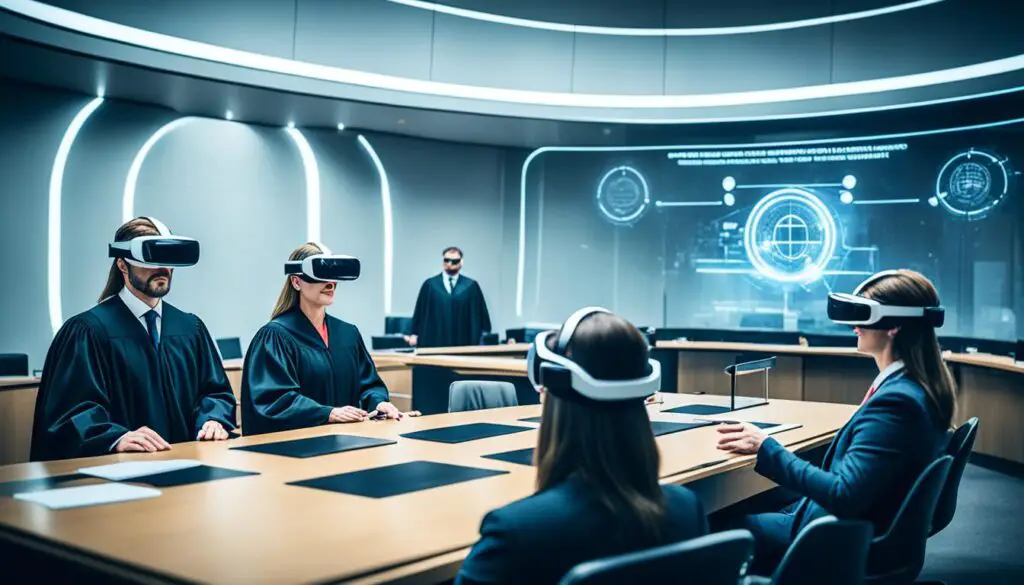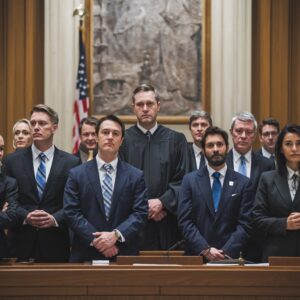
In today’s rapidly evolving digital landscape, the legal industry is undergoing a significant transformation. Technology is revolutionizing the way legal professionals practice law, streamlining processes, improving efficiency, and enhancing client services. As we look to the future, it is crucial to stay informed about the top legal tech trends that are shaping the future of law.
Advancements in legal technology are opening up new possibilities and presenting new challenges for legal professionals. From artificial intelligence-powered legal research tools to blockchain-based smart contracts, the intersection of law and technology holds immense potential to revolutionize traditional legal practices.
By embracing these emerging legal tech trends, law firms and legal departments can stay ahead of the curve and gain a competitive edge in the industry. Whether it’s leveraging cloud-based case management systems or utilizing predictive analytics for better decision-making, technology is paving the way for a more efficient and client-centric legal ecosystem.
Key Takeaways:
- Technology is transforming the legal industry, presenting opportunities for improved efficiency and client services.
- Emerging legal tech trends, such as artificial intelligence and blockchain, offer new possibilities and challenges.
- Law firms and legal departments can stay competitive by embracing and integrating relevant legal technologies.
- Cloud-based case management systems and predictive analytics are among the cutting-edge tools revolutionizing legal practices.
- Staying informed about legal tech trends is essential for legal professionals navigating the evolving landscape of law in the digital age.
The Importance of Culture and Brand Alignment in HR
Culture and brand alignment play a vital role in the success of organizations. When the culture and brand are aligned, it creates a cohesive and authentic experience for customers. This alignment ensures that the organization’s values, mission, and actions are consistent, leading to increased trust and loyalty from customers.
Leaders within the organization have a significant responsibility in fostering culture and brand alignment. Through leadership development programs and coaching, they can guide employees in embodying the organization’s culture and aligning their work with the brand’s values. By exemplifying these values themselves, leaders inspire their teams and establish a strong foundation for culture and brand alignment.
In today’s evolving business landscape, leaders need to possess certain qualities to drive culture and brand alignment effectively. They need to be curious, constantly seeking opportunities to enhance the organizational culture and align it with the brand identity. Inspirational leadership inspires and motivates employees to embrace the organization’s values and live them in their day-to-day actions.
Leading with empathy and authenticity is also crucial in creating a culture of inclusion and belonging. Employees must feel heard, valued, and supported. Leaders who prioritize transparency and accountability foster a sense of trust and create an environment where employees feel safe to express their ideas and concerns. This leads to stronger culture and brand alignment as employees become actively involved in shaping the organizational culture.
“Culture does not change because we desire to change it. Culture changes when the organization is transformed; the culture reflects the realities of people working together every day.” – Frances Hesselbein
Leadership’s Role in Brand Alignment
One of the key aspects of culture and brand alignment is leadership’s role in ensuring that the organization’s values and brand identity are integrated into all aspects of the business. Leaders set the tone for the organization and serve as brand ambassadors, embodying the brand’s values and principles.
By aligning leadership development programs with the organization’s brand identity, leaders can effectively communicate the brand’s values and ensure that these values are manifested throughout the organization. This includes aligning hiring practices, performance evaluations, and employee development initiatives with the brand’s values and culture.
The following table illustrates the various ways in which leaders can drive culture and brand alignment:
| Leadership Actions | Impact on Culture and Brand Alignment |
|---|---|
| Setting a vision and reinforcing the brand’s values | Ensures consistent alignment between culture and brand |
| Providing leadership development programs | Equips leaders with skills to embody and promote the brand’s values |
| Leading by example | Inspires employees to align their actions with the brand’s values |
| Promoting transparency and accountability | Fosters a culture of trust and authenticity |
| Emphasizing diversity and inclusion | Strengthens brand perception and fosters a culture of belonging |
By focusing on these leadership actions, organizations can create a culture that aligns with the brand’s identity, resulting in a stronger brand image, increased customer satisfaction, and improved overall performance.
Brand alignment is not a one-time effort but an ongoing process that requires continuous evaluation, feedback, and adjustment. Organizations must prioritize culture and brand alignment, as it has a direct impact on employee engagement, customer satisfaction, and ultimately, the organization’s success.
Strategies for Aligning Culture and Brand
Aligning culture and brand is essential for organizations to create a cohesive and authentic experience for customers. Citizens Financial Group, a leading financial institution, has implemented a bottom-up approach to culture and brand alignment through the use of business resource groups.
These business resource groups are composed of employees from diverse backgrounds who come together to foster diversity and inclusion, drive product development, influence policy decisions, and engage with the community. By involving employees at all levels, Citizens Financial Group ensures that its culture and brand are aligned with the needs and values of its workforce and the broader society.
The company currently has six active business resource groups, each focusing on a specific area of diversity and inclusion, such as gender, ethnicity, LGBTQ+ rights, and more. These groups play a vital role in shaping the organization’s culture, promoting inclusivity, and enhancing the brand’s reputation.
Annual meetings between the business resource group members and top leadership provide an opportunity to collaborate, share ideas, and discuss strategies for aligning culture and brand. These meetings serve as a platform for open dialogue, fostering a sense of inclusivity and empowering employees to contribute to the alignment process.
One example of the impact of this bottom-up approach is the development of inclusive financial products tailored to specific communities. Through the input of business resource groups, Citizens Financial Group gains valuable insights into the diverse needs of its customers, enabling the creation of innovative and inclusive financial solutions.
Furthermore, the business resource groups actively engage with the community through various initiatives and partnerships, demonstrating the organization’s commitment to social responsibility and community engagement. This community-centric approach strengthens the alignment between the company’s culture, brand, and external stakeholders.
In summary, the bottom-up approach implemented by Citizens Financial Group, utilizing business resource groups, has proven to be an effective strategy for aligning culture and brand. This approach ensures diversity and inclusion efforts, product development, policy decisions, and community engagement are all guided by the collective wisdom and perspectives of employees. By empowering employees to contribute to the alignment process, Citizens Financial Group creates a culture of inclusivity, strengthens its brand, and fosters meaningful connections with its community.
Conclusion
In conclusion, the future of law is being shaped by the ongoing advancements in legal tech trends. With the rapid integration of technology and digital solutions, the legal industry is undergoing a significant transformation. To remain competitive in this ever-changing landscape, organizations must prioritize staying updated on the latest legal tech trends and embracing innovation.
By leveraging technology, legal professionals can streamline their processes, improve efficiency, and enhance client experiences. From AI-powered legal research tools to blockchain-based smart contracts, technology is revolutionizing how legal services are delivered.
Furthermore, organizations should also focus on aligning their culture and brand with these tech-driven changes. Embracing diversity and inclusion within the legal profession is crucial for fostering innovation and adapting to the evolving needs of clients.
Investing in leadership development programs that emphasize digital literacy and technological proficiency will equip legal professionals with the skills necessary to navigate the future of law successfully.
FAQ
How are church-run border shelters in Mexico preparing for the arrival of migrants?
Church-run border shelters in Mexico are preparing for the arrival of large groups of migrants from southern Mexico. They are working together to provide shelters and support services for the incoming migrants.
What is the purpose of the Way of the Cross caravan organized by Mexican activists?
The Way of the Cross caravan organized by Mexican activists aims to ensure the safety of vulnerable people as they travel through Mexico.
What challenges do migrants often face on their journey?
Migrants have limited options and often face danger and exploitation along the way.
How can leaders foster culture and brand alignment?
Leaders can foster culture and brand alignment through leadership development programs and coaching. They need to be curious, inspirational, and lead with empathy and authenticity.
How does Citizens Financial Group align culture and brand?
Citizens Financial Group has implemented a bottom-up approach to aligning culture and brand through the use of business resource groups. These groups inform diversity, equity, and inclusion efforts, product development, policy decisions, and community engagement.
How many business resource groups does Citizens Financial Group have?
Citizens Financial Group has six business resource groups with active employee involvement.
How does aligning culture and brand create inclusivity?
Aligning culture and brand creates a sense of inclusivity and empowers employees to contribute to the cultural and brand alignment process.
How can organizations navigate the evolving legal landscape?
Organizations can navigate the evolving legal landscape by staying updated on the latest legal tech trends, embracing innovation, and investing in leadership development.
Why is embracing diversity and inclusion important in the legal industry?
Embracing diversity and inclusion is important in the legal industry to create a culture of inclusion and belonging, and to remain competitive in the digital age.










